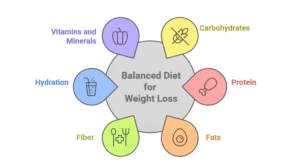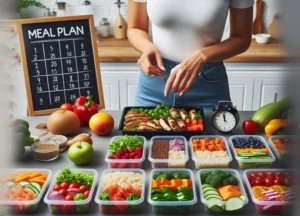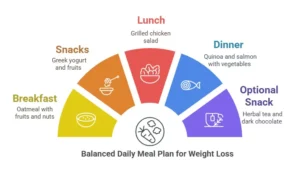What is a Good Balanced Diet for Weight Loss: Tips and Meal Ideas for Women

Are you tired of chasing diets that promise quick fixes but leave you hungry and frustrated? The solution may be simpler than you think: a “balanced diet for weight loss”. Unlike restrictive diets, a balanced diet provides your body with all the nutrients it needs while maintaining a calorie deficit for gradual, sustainable weight loss.
This approach isn’t just about eating less. It’s about eating smarter. Adding the right mix of protein, healthy fats, carbohydrates, and fiber makes you feel full, energized, and more in control of your weight. Studies show a balanced diet helps you shed pounds and improves overall health and well-being.
This article will break down the components of a balanced diet, how it helps you lose weight, and provide practical tips for incorporating it into your daily life.
How does a balanced diet help you lose weight?
What is a balanced diet?
A well-balanced diet gives your body all the required nutrients to perform at its best while maintaining general health. It includes a variety of foods in the right proportions to ensure that you get the macronutrients and micronutrients without consuming too many calories. This type of diet not only helps with weight loss but also supports energy levels, immunity, and long-term well-being.
A Balanced Diet and Weight Loss
Eating less than your body burns results in a calorie deficit, which causes weight loss. A balanced diet ensures that you stay nourished while consuming fewer empty calories. Research published in The American Journal of Clinical Nutrition shows that nutrient-dense foods improve metabolism and aid in sustainable weight loss.
Nutrient-rich foods like vegetables, whole grains, and lean proteins are high in fiber and water content, making them more filling while reducing calories. For example, switching from white bread to whole-grain bread or adding salad to your meals can reduce hunger and prevent overeating.
A balanced diet includes all three macronutrients (carbohydrates, protein, fat), which stabilize blood sugar levels and reduce cravings. For example, a meal of grilled chicken, quinoa, and steamed vegetables provides protein, fiber, and healthy carbohydrates, keeping you satisfied and energized.
Consistency is key to sustainable weight loss. Eating regular, balanced meals helps regulate your metabolism and reduces the likelihood of overeating or unhealthy snacking. A study published in Obesity Research highlights that people who follow an eating structure are likelier to achieve and maintain their weight loss goals.
Components of a Well-Balanced Diet for Weight Loss

Carbohydrates
Carbohydrates are the body’s main energy source, but not all carbohydrates are created equal. Complex carbohydrates, found in whole grains and vegetables, are digested more slowly, which keeps you fuller longer and keeps blood sugar levels stable. On the other hand, simple carbohydrates, such as sugary drinks and processed snacks, can cause blood sugar to spike, leading to hunger and overeating.
The best sources are quinoa, oats, sweet potatoes, brown rice, whole-grain bread, and vegetables like broccoli and spinach. These options are high in fiber and nutrients, making them great for weight loss.
Protein
Protein is essential for weight loss because it promotes satiety, helping you eat fewer calories throughout the day. Plus, protein helps preserve muscle, which is important for maintaining a healthy metabolism, especially when losing weight.
The best sources are lean meats (chicken, turkey), eggs, legumes (lentils, chickpeas), tofu, fish, and low-fat dairy products like Greek yogurt. These foods are nutritious and versatile for meal planning.
Fats
Healthy fats play an important role in overall health and weight loss. They help regulate hormones, improve brain function, and provide long-lasting energy. Including the right fats in your diet can help you feel satisfied, reducing the temptation to snack on unhealthy options.
The best sources are avocados, nuts (almonds, walnuts), seeds (chia, flax), olive oil, and fatty fish (salmon, mackerel). These foods are high in monounsaturated and omega-3 fatty acids, which are good for your heart and metabolism.
Fiber
Fiber is essential for digestion and weight loss. It adds bulk to your meals, helping you feel full while consuming fewer calories. Fiber also slows digestion, stabilizes blood sugar levels, and reduces cravings for unhealthy snacks.
The best sources are fruits (apples, berries), vegetables (broccoli, carrots), whole grains (brown rice, oats), and legumes (beans, lentils). Including a mix of these foods ensures you get enough fiber for weight management and gut health.
Hydration
Water is often overlooked but plays an important role in weight loss. It helps regulate body temperature, aids digestion, and reduces hunger by mimicking fullness. Staying hydrated boosts your metabolism, which helps your body burn calories more efficiently.
Tips:
- Start your day with a glass of water.
- Bring a reusable water bottle with you at all times.
- Slices of lemon, cucumber, or mint can be added for flavor.
- Set reminders to drink water regularly.
Vitamins and Minerals
Vitamins and minerals are essential for bodily functions, including metabolism, immunity, and energy production. Deficiencies in these nutrients can slow your weight loss progress and affect your overall health. Examples of nutrient-rich foods are:
- Vitamin C: Citrus fruits, bell peppers, and strawberries.
- Calcium: Dairy, almonds, and leafy greens like kale.
- Iron: Spinach, beans, and lean red meat.
- Magnesium: Nuts, seeds, and whole grains.
Creating a Balanced Meal Plan for Weight Loss

Meal Timing and Frequency
Regular eating is necessary to prevent overeating when you’re hungry. Skipping meals can slow down your metabolism and lead to unhealthy food choices.
- Breakfast: Within an hour of waking up to boost metabolism.
- Lunch: Midday to refuel your body.
- Dinner: At least 2-3 hours before bed to aid digestion.
- Snacks: Healthy options between meals to maintain energy levels and curb cravings.
Portion Control and Calorie Intake
Even healthy foods can hinder weight loss if eaten in large quantities. Portion control ensures eating the right amount of each food group to meet your daily calorie needs. Using smaller plates, measuring portions, and being mindful of serving sizes are effective strategies for portion control.
- To manage serving sizes, use smaller dishes and plates.
- Follow the plate method; half your plate with vegetables, a quarter with protein, and a quarter with whole grains.
- Track calories using apps like MyFitnessPal or a food journal to stay on target.
Foods to Include in a Balanced Diet
Fruits and Vegetables
Fruits and vegetables are low in calories but high in essential nutrients, making them ideal for weight loss. They are packed with vitamins, minerals, and antioxidants that support metabolism and overall health. The fiber in fruits and vegetables promotes satiety, reducing the likelihood of overeating—for example, leafy greens like spinach and kale, cruciferous vegetables like broccoli and cauliflower, berries, oranges, and apples.
Whole grains and legumes
Whole grains and legumes are rich in fiber and complex carbohydrates, which provide sustained energy and keep you full for longer. Unlike refined carbohydrates, whole grains are nutrient-dense and help stabilize blood sugar levels—for example, brown rice, quinoa, oats, lentils, chickpeas, and black beans.
Lean Protein and Healthy Fats
Lean proteins are essential for muscle preservation and repair, while healthy fats help regulate hormones and increase the absorption of fat-soluble vitamins. Including both in your meals ensures a well-rounded nutritional profile that promotes satiety and prevents unhealthy snacking.
Examples:
- Lean proteins: Skinless chicken, turkey, fish, eggs, tofu, and beans.
- Healthy fats: Avocado, nuts, seeds, olive oil, and fatty fish like salmon.
Low-calorie beverages
Replacing sugary drinks with low-calorie drinks helps reduce empty calories, and enables you to stay hydrated, essential for weight loss. Some beverages, like green tea, can boost metabolism due to their antioxidant content.
Examples: water, green tea, herbal tea, and water infused with lemon or mint for flavor.
Avoid or limit foods for weight loss
Processed and junk foods
Processed foods are often high in calories, added sugars, unhealthy fats, and sodium, while providing little nutritional value. Regularly consuming these foods can lead to weight gain and hinder weight loss efforts. Examples include chips, cookies, packaged snacks, and frozen meals.
Sugary drinks and snacks
Sugary drinks and snacks are full of empty calories providing little or no nutritional benefit. They can cause a blood sugar spike and subsequent crash, leading to cravings and overeating. Examples: soda, fruit juices with added sugar, candy, and baked goods like cakes and muffins.
Refined carbohydrates
Refined carbohydrates, like white bread, and pastries, are stripped of their natural fiber and nutrients. They can cause rapid increases in blood sugar, hunger pangs, and increased fat storage—for example, white bread, white rice, regular pasta, and sugary cereals.
Excess saturated fat and trans fat
Saturated fat and trans fat are commonly found in fried and processed foods, which increase the risk of weight gain and heart disease—for example, fried chicken, burgers, donuts, and baked goods packaged with hydrogenated oils.
Also, read Healthy Sweet Snacks for Weight Loss.
Sample Balanced Meal Plan (Days/Week)

Here’s a sample day of balanced meals to guide you:
- Breakfast: 1 cup oatmeal with sliced banana, blueberries, and a handful of almonds.
- Morning snack: A small bowl of Greek yogurt with a drizzle of honey and a sprinkle of chia seeds.
- Lunch: A grilled chicken salad with mixed greens, cherry tomatoes, cucumbers, and a tablespoon of olive oil and lemon dressing.
- Afternoon snack: A piece of fruit such as an apple or pear, paired with a handful of walnuts.
- Dinner: Quinoa and herb-roasted salmon with roasted vegetables (zucchini, carrots, bell peppers).
- Evening snack (optional): A cup of herbal tea and a small piece of dark chocolate (85% cocoa or higher).
Rotate proteins, grains, and vegetables to keep meals interesting and nutritionally diverse for a week plan.
Common mistakes to avoid when following a balanced diet
- While calorie restriction is essential for weight loss, excessive restriction can be detrimental. Extremely low-calorie diets can slow metabolism, cause nutrient deficiencies, and lead to fatigue. Similarly, cutting out entire food groups (such as carbohydrates or fats) can deprive your body of essential nutrients.
- Even healthy foods can lead to weight gain if eaten in large quantities. It’s easy to underestimate portion sizes, resulting in higher calorie intake. Using a measuring cup or food scale can help you manage portions accurately.
- Fad diets promise quick weight loss but are often unsustainable in the long term. They can lead to weight loss and regain, making it difficult to maintain a healthy lifestyle. Instead, focus on balanced eating habits, you can stick with for life.
- Emotional eating or turning to food during stress can derail weight loss progress. Identify triggers and develop alternative coping mechanisms, such as journaling, meditation, or physical activity.
Tips for Sticking to a Balanced Diet
- Meal prepping is a powerful strategy for sticking to a balanced diet. You can save time by preparing meals and snacks beforehand during the week and avoid impulsive, unhealthy choices. Plan your meals, cook in batches, and conveniently store portions in containers. Use Sunday or your least busy day to plan and prepare meals for the week ahead.
- When grocery shopping, focus on buying whole, unprocessed foods like fruits, vegetables, whole grains, lean protein, and healthy fats. Avoid aisles full of processed snacks and sweets. Reading food labels can help you avoid hidden sugars, unhealthy fats, and additives. Make a shopping list and stick to it to prevent unnecessary purchases.
- Mindful eating involves focusing on your food, chewing slowly, and savoring the flavors and textures of your food. This practice can help you feel satisfied with smaller portions and avoid overeating. Avoid distractions like watching TV or scrolling through your phone while eating. Pause between bites and listen to your body’s hunger and fullness cues.
- Cravings often derail your balanced diet, but finding healthy alternatives can help. For example, swap chips for air-popped popcorn, ice cream for Greek yogurt with fruit, or sweetened beverages for water or herbal tea. Keep healthy snacks, like nuts, fruit, or veggie sticks, to satisfy cravings without compromising your diet.
Conclusion
A balanced diet is not just a way to lose weight but a sustainable lifestyle choice that promotes overall well-being. You can create a routine that promotes healthy habits by incorporating nutrient-dense foods, practicing mindful eating, and planning meals with thought.
Remember, weight loss is not about deprivation but about nourishing your body with the right foods in the right amounts. Embrace the journey with patience, consistency, and a positive mindset, and you’ll reap the rewards of better energy, better health, and a more confident you.
Frequently Asked Questions
1. Can I follow a balanced diet without dietary restrictions or food allergies?
Absolutely. A balanced diet can be customized to suit your dietary needs. For example, if you’re lactose intolerant, you can opt for dairy-free alternatives like almond milk or soy yogurt. Similarly, if you are sensitive to gluten, choose gluten-free whole grains like quinoa or rice. Consulting a dietitian can help you create a plan that works for you.
2. Do I need to take supplements while following a balanced diet?
Supplements are not always necessary if your diet includes nutritious foods. However, supplements may be recommended if you have a specific deficiency (for example, vitamin D, B12, or iron). Always consult a healthcare provider before starting any supplements.
3. Can a balanced diet help with hormonal imbalances?
A balanced diet rich in whole foods, healthy fats, and lean protein can support hormonal health. For example, omega-3 fatty acids in fatty fish and flax seeds can help regulate hormones, while avoiding excess sugar can stabilize insulin levels.
4. How can I balance eating out while on a balanced diet?
When eating out, look for menu options like grilled proteins, salads, or dishes with whole grains and vegetables. Avoid fried or creamy foods, and ask for dressings or sauces on the side. Portion control is also key — consider sharing dishes or packing leftovers.
5. How long does it take to see results from a balanced diet?
The timeline is different for everyone depending on factors like metabolism, activity level, and consistency. Significant weight loss and improved energy levels can occur within a few weeks. However, the long-term health benefits are far more rewarding and worth the effort.
6. Is indulging in cheat meals while on a balanced diet okay?
Yes, occasional indulgences are okay and can even help you stay motivated. The key is moderation. A cheat meal won’t derail your progress, but making unhealthy choices over and over again can. Balance your meals before and after nutritious meals.
7. How can I manage emotional eating while maintaining a balanced diet?
Emotional eating can be managed by identifying triggers and finding alternative coping mechanisms, such as exercising, journaling, or talking to a friend. Keeping healthy snacks available and practicing mindful eating can also help prevent emotional eating.
8. Can I do intermittent fasting with a balanced diet?
Yes, intermittent fasting can be combined with a balanced diet if it fits your lifestyle. Focus on consuming nutritious foods during your eating window. However, listen to your body to meet your nutritional needs.






